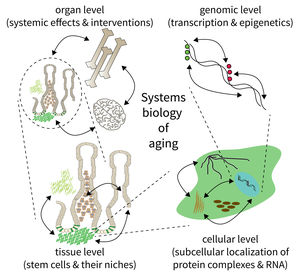Subarea 5: Computational and Systems Biology of Aging
Subarea 5 focuses on the development of methods to analyse and understand complex biological systems. This work includes the design of computer algorithms and biostatistical approaches as well as the development of novel Omic strategies (i.e. genomics/epigenomics, transcriptomics, proteomics, and metabolomics) to study aging and aging-related diseases. According to the FLI, due to the Subarea's expertise in computational data analysis, it is deeply interconnected with all other Subareas. The Subarea hosts two critical core facilities (Life Science Computing, Proteomics) and provides consulting services in statistics. Furthermore, it organizes courses on data analysis and statistics.
The research is defined by five focus areas:
- Mapping extrinsic and intrinsic factors influencing stem cells during aging,
- Integration of spatiotemporal proteomics and transcriptomics data,
- Comprehensive evaluation of qualitative and quantitative expression changes,
- Identification and analysis of epigenomic alterations during aging and age-related diseases, and
- Network analysis of genomic, transcriptomic and epigenomic alterations during aging.
Research focus of Subarea 5.
The biology of aging can be viewed as a multilayered array of networks at the level of organs, cells, molecules, and genes. The FLI wants to meet this complexity by establishing the new Subarea on “Computational and Systems Biology of Aging”. The overall goal is to interconnect research at different scales, taking place in Subareas 1-4 of the Institute’s research program. The new group on Systems Biology will integrate data from networks at multiple scales and will thus point to mechanisms and interactions that would not be seen in unilayer approaches.
Publications
(since 2016)
2020
- Increased prostaglandin-D2 in male STAT3-deficient hearts shifts cardiac progenitor cells from endothelial to white adipocyte differentiation.
Stelling E, Ricke-Hoch M, Erschow S, Hoffmann S, Bergmann AK, Heimerl M, Pietzsch S, Battmer K, Haase A, Stapel B, Scherr M, Balligand JL, Binah O, Hilfiker-Kleiner D
PLoS Biol 2020, 18(12), e3000739 - Butler enables rapid cloud-based analysis of thousands of human genomes.
Yakneen S, Waszak SM, PCAWG Technical Working Group, Gertz M, Korbel JO, PCAWG Consortium
Nat Biotechnol 2020, 38(3), 288–292 - Comprehensive molecular characterization of mitochondrial genomes in human cancers.
Yuan Y, Ju YS, Kim Y, Li J, Wang Y, Yoon CJ, Yang Y, Martincorena I, Creighton CJ, Weinstein JN, Xu Y, Han L, Kim HL, Nakagawa H, Park K, Campbell PJ, Liang H, PCAWG Consortium
Nat Genet 2020, 52(3), 342-52 - The landscape of viral associations in human cancers.
Zapatka M, Borozan I, Brewer DS, Iskar M, Grundhoff A, Alawi M, Desai N, Sültmann H, Moch H, PCAWG Pathogens, Cooper CS, Eils R, Ferretti V, Lichter P, PCAWG Consortium
Nat Genet 2020, 52(3), 320-30
2019
- Quantitation of Reactive Acyl-CoA Species Mediated Protein Acylation by HPLC-MS/MS.
Baldensperger T, Simone DS, Ori A, Glomb MA
Anal Chem 2019, 91(19), 12336-43 - Cohesin-mediated NF-κB signaling limits hematopoietic stem cell self-renewal in aging and inflammation.
Chen Z, Amro EM, Becker F, Hölzer M, Rasa SMM, Njeru SN, Han B, Di Sanzo S, Chen Y, Tang D, Tao S, Haenold R, Groth M, Romanov VS, Kirkpatrick JM, Kraus JM, Kestler HA, Marz M, Ori A, Neri F, Morita** Y, Rudolph** KL
J Exp Med 2019, 216(1), 152-75 ** co-corresponding authors - Comment on 'Naked mole-rat mortality rates defy Gompertzian laws by not increasing with age'.
Dammann* P, Scherag* A, Zak N, Szafranski K, Holtze S, Begall S, Burda H, Kestler HA, Hildebrandt T, Platzer M
Elife 2019, 8 * corresponding author - Karyopherin α2-dependent import of E2F1 and TFDP1 maintains protumorigenic stathmin expression in liver cancer.
Drucker E, Holzer K, Pusch S, Winkler J, Calvisi DF, Eiteneuer E, Herpel E, Goeppert B, Roessler S, Ori A, Schirmacher P, Breuhahn K, Singer S
Cell Commun Signal 2019, 17(1), 159 - Conservation and divergence of the p53 gene regulatory network between mice and humans.
Fischer M
Oncogene 2019, 38(21), 4095-109 - Profiling of gallbladder carcinoma reveals distinct miRNA profiles and activation of STAT1 by the tumor suppressive miRNA-145-5p.
Goeppert B, Truckenmueller F, Ori A, Fritz V, Albrecht T, Fraas A, Scherer D, Silos RG, Sticht C, Gretz N, Mehrabi A, Bewerunge-Hudler M, Pusch S, Bermejo JL, Dietrich P, Schirmacher P, Renner M, Roessler S
Sci Rep 2019, 9(1), 4796









